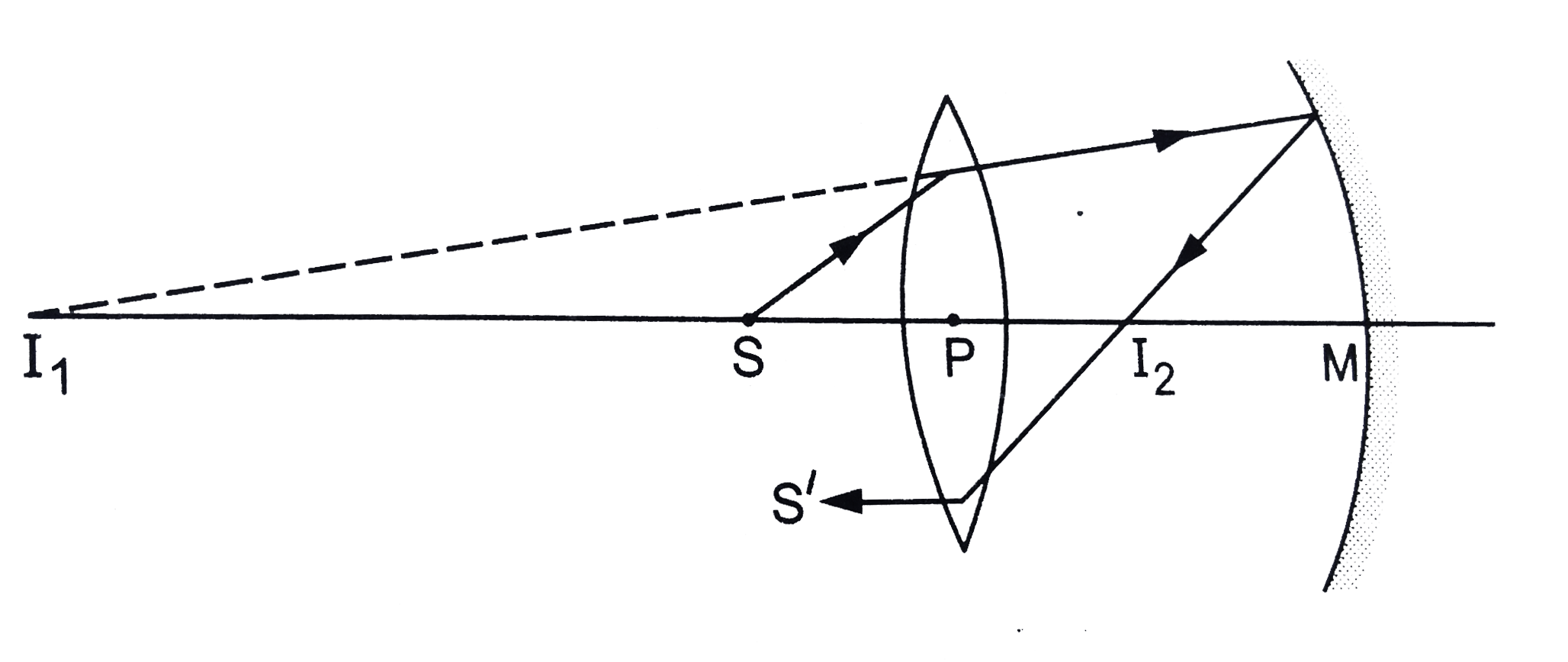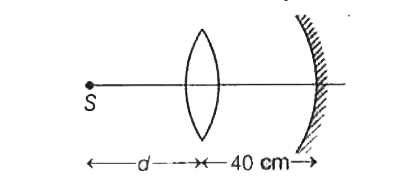A converging lens of focal length 15 cm and a converging mirror of focal length 20 cm are placed with their principal axes coinciding. A point source S is placed on the principal axis at a distance of 12 cm from the lens as shown in figure. It is found that the final beam comes out parallel to the principal axis. Find the separation between the mirror and the lens.
 Solution in Tamil
Solution in Tamil
Let us first locate the image of S formed byi the lens L. Here u=−12cmandf=15cm. We have
1v−1u=1f
or1v=1f+1u
=115cm−112cm
orv=−60cm
The negative sign shows that the image is formed to the left of the lens as suggeted in the ure. The image I1 acts as the source for the mirror. The mirror forms and image I2 of the source I1. This image I_2 then acts as the source for the lens and the fiN/Al beam comes out parallel to the principal axis. Clearly I2 must be at the focus of the lens. We have
I1I2=I1L+L2=60cm15cm=75cm.
Suppose the distance of the mirror from I2 is x cm. For the reflection from the mirror.
u=MI1(=−(75+x)cm,v=−xcm=75cm
Suppose the distance of the mirror from I2 is cm. For the reflection from the mirror.
u=MI1=−(75+x)cm,v=−xcmandf=−20cm
Using 1v+1u=1f
1x+175+x=120
or75+2x(75+x)x=120
orx2+35−1500=0
or x=−35±√35×35+4x15002
This gives x=25 or -60.
As the negatives sign has no physical meaning only positive sigh should be taken. Taking x=25 the separatioin between the lens and the mirror is (15+25)cm=40cm.
Topper's Solved these Questions
- BOOK - HC VERMACHAPTER - GEOMETRICAL OPTICSEXERCISE - Question For short Answer19videos
GEOMETRICAL OPTICS
- BOOK - HC VERMACHAPTER - GEOMETRICAL OPTICSEXERCISE - Objective -118videos
GEOMETRICAL OPTICS
- BOOK - HC VERMACHAPTER - GEOMETRICAL OPTICSEXERCISE - Exercises79videos
GEOMETRICAL OPTICS
- BOOK - HC VERMACHAPTER - GAUSS LAWEXERCISE - Exercises24videos
GAUSS LAW
- BOOK - HC VERMACHAPTER - LIGHT WAVESEXERCISE - Exercises41videos
LIGHT WAVES
Similar Questions
Is the formula "Real depth/Apparent depth =μ. valid if viewed from a position quite away from the normal ?
10:19View SolutionA point source of light is placed in front of a plane mirror.
04:46View SolutionA concave mirror having a radius of curvature 40 cm is placed in front of an illuminated point source at a distance of 30 cm from it. Find the location of the image.
06:18View SolutionThe electric field in a region is given by →E=35E0→i+45E0→j with E0=2.0×103NC−1. Find the flux of this field through a recatngular surface of area 0.2m2 parallel to the y-z plane.
02:10View SolutionFind the range of frequency of light that is visible to an average human being (400nm<λ<700nm)
02:49View SolutionA converging lens of focal length 12 cm and a diverging mirror of focal length 7.5 cm are placed 5.0 cm apart with their principal axes coinciding. Where should an object be placed so that its image falls on itself ?
03:28View SolutionA converging lens and a diverging mirror are placed at a separation of 15 cm. The focal length of the lens is 25 cm and that of the mirror is 40 cm. Where should a point source be placed between the lens and the mirror so that the light, after getting reflected by the mirror and then getting transmitted by the lens, comes out parallel to the principal axis ?
04:44View SolutionA converging lens of focal length 15 cm and a converging mirror of focal length 10 cm are placed 50 cm apart with common principal axis. A point source is placed in between the lens and the mirror at a distance of 40 cm from the lens. Find the locations of the two images formed.
04:32View SolutionA converging lens and a converging mirror are placed with their principal axis coinciding. Their separation equals 40cm. A point source S is placed on the principal axis at a distance of 12 cm from the lens as shown in Fig. It is found that the final beam comes out parallel to the principal axis. Focal length of the lens equals 15 cm. Find the focal length of the mirror.
04:16View SolutionA converging lens of focal length 20 cm and a converging mirror of focal length 10 cm are placed 60 cm apart with common principal axis. A point source is placed in between the lens and the mirror at a distance of 50 cm from the lens. Find the locations of the images formed.
08:54View SolutionA converging lens and a diverging mirror are placed at a separation of 20 cm. The focal length of the lens is 30 cm and that of the mirror is 50 cm. Where should a point source be placed between the lens and the miror, so that the light, after getting reflected by the mirror and then getting transmitted by the lens, comes out parallel to the principal axis?
View SolutionA converging mirror is placed on the right hand side of a converging lens as shown in the figure. The focal length of the mirror and the lens are 20 cm and 15 cm, respectively. The separation between the lens and the mirror is 40 cm and their principal axis coincide. A point source is placed on the principal axis at a distance d to the left of the lens. If the final beam comes out parallel to the principal axis, then the value of d is
 View Solution
View SolutionA converging lens of focal length 12 cm and a diverging mirror of focal length 7.5 cm are placed 5.0 cm apart with their principal axes coinciding. Where should an object be placed so that its image falls on itself ?
03:37View SolutionA converging lens and a diverging mirror are placed at a separation of 15 cm. The focal length of the lens is 25 cm and that of the mirror is 40 cm. Where should a point source be placed between the lens and the mirror so that the light, after getting reflected by the mirror and then getting transmitted by the lens, comes out parallel to the principal axis ?
03:56View SolutionA converging lens of focal length 15 cm and a converging mirror of focal length 10 cm are placed 50 cm apart with common principal axis. A point source is placed in between the lens and the mirror at a distance of 40 cm from the lens. Find the locations of the two images formed.
05:13View SolutionA converging lens of focal length 12 cm and a diverging mirror of focal length 7.5 cm are placed 5.0 cm apart with their principal axes coinciding. Where should an object be placed so that its image falls on itself?
View Solution

